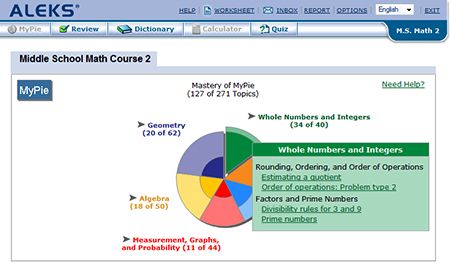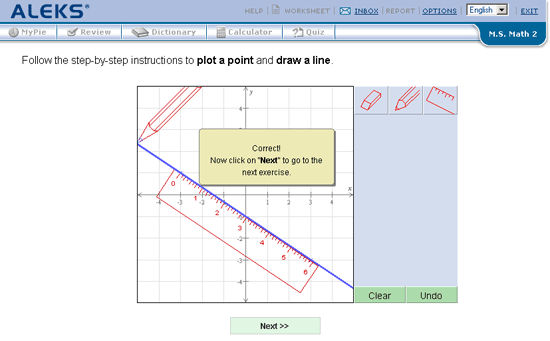Our review this week is an online subscription service called ALEKS--an acronym. According to the company's website:
Assessment and LEarning in Knowledge Spaces is an online mathematics program that provides personalized learning and assessment tailored to a student's individual needs. Using artificial intelligence and adaptive, open-response questioning, ALEKS quickly and accurately determines what a student knows and is most ready to learn within a course. Learn more by watching a quick 2-minute video.
With a comprehensive course library ranging from elementary school math to complex subjects such as PreCalculus, ALEKS acts much like a human tutor to help take the stress off of homeschooling parents.
ALEKS offers highly-targeted, individualized instruction from virtually any computer with Internet access, making it a comprehensive and mobile education solution for students in grades 3-12. A subscription to ALEKS offers access to all courses and students may take as many courses as needed during their subscription period.
The subscription rate is $19.95/month for one student. The monthly cost can be lowered by selecting a six or twelve month subscription. Families with more than one child can also receive a discount for additional students on the 6 or 12 month plans.
The student begins by taking an assessment test. My Schnickelfritz took the third grade test and for a hoot I set myself up as a beginning algebra student. There is no time limit to these tests and no real advantage to guessing. When Fritz had several geometry based questions he had never been exposed to before, he simply clicked "I don't know." After his 28 questions (and my 30) we were shown our individual pie charts, similar to the one shown below.
The darker colors reflect mastery of math concepts and the lighter areas show where subjects need to be introduced or more work is necessary. For myself, I found the chart to be fairly accurate--I was actually laughing at how much I've forgotten about exponents (but I still aced factoring). Fritz's pie chart was less of a reflection of what he actually knew. As you can see in the sample there are 271 topics to be learned and the assessment test only had 28 questions. The first two lessons suggestions for Fritz was to estimate the answer before solving addition and the subtraction problems--something he has been doing with our regular math curriculum for years. It wasn't really an issue. Fritz just answered two math problems for each topic and the darkened section of the pie grew accordingly.
Clicking on a pie section will open a box with a suggestion of topics to try next. When you click on the topic it appears that you're taking a quiz again, that is it begins with a math problem for you to solve. If you can't solve the problem you can click on the "Explain" button underneath the problem. This puts you in learning mode. The topic will be explained in general terms and then the specific problem you were given will be solved. The explanation can be very brief. It worked for me as I usually just needed a refresher but when Fritz was encountering new topics for the first time he occasionally got frustrated by what he considered "not enough teaching." My concern on the other hand was that it only took two correct answers after the brief explanation to earn the mastered status. Had he really mastered the material or was he just able to hold the idea in short term memory and it would be lost the next day? ALEKS deals with this issue by requiring the student to complete reassessments from time to time to see what has actually been retained.
There were a few types of math problems that seemed awkward to solve via the computer, especially in the algebra level. Writing answers with multiple sets of parentheses with both a numerator and denominator involved typing in a specific sequence and clicking buttons on the side to create fractions or add exponents. It was almost like solving the problem twice--once on paper and once figuring how to put in in computer format, but it was do-able with a little practice. Fritz struggled with using the ruler feature to draw lines. There was a tutorial for this during the assessment test.
As the teacher, every other week I received an email with a progress report. I would be told what percentage of each category had been mastered and how much time Fritz had used the ALEKS program. A more detailed report was available by clicking a link included in the email.
Because Fritz has already mastered his adding and subtracting facts and times tables, he did not use the QuickTables feature or the games available there.
At this time, ALEKS is not a good fit for our family. I see it as more of an assessment tool than a teaching tool. Since I am teaching him in a one-on-one basis, I already know what topics he's mastered and what we still need to work on. ALEKS may be more useful to the mom of multiples that can't oversee every one's math lessons as thoroughly as she'd like. On the other hand, ALEKS has a pretty high monthly cost and using it with large families could be a financial burden.
 The best way to see if ALEKS is a good fit for your family is to try it yourself! ALEKS has a two-month free trial available by clicking the box to the left.
The best way to see if ALEKS is a good fit for your family is to try it yourself! ALEKS has a two-month free trial available by clicking the box to the left.
You can read what others on the Homeschool Crew thought of their ALEKS trial by clicking here.






No comments:
Post a Comment